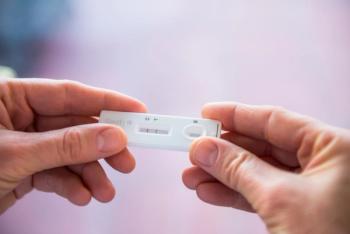
- Consultant for Pediatricians Vol 7 No 10
- Volume 7
- Issue 10
Sacral Epidermal Anomalies in an Infant
Two-month-old boy with divot in the lower back, shown here with the gluteal crease relaxed (A) and spread (B). Infant is a product of an uncomplicated pregnancy and delivery. Nursery stay uneventful. Subsequent feeding and growth normal. Parents report no problems with urination or defecation.
A 2-month-old boy with divot in the lower back, shown here with the gluteal crease relaxed (FigureA) and spread (Figure B). Infant is a product of an uncomplicated pregnancy and delivery. Nursery stay uneventful. Subsequent feeding and growth normal. Parents report no problems with urination or defecation.
No drainage of fluid from the indentation. No swelling, redness, or tenderness. Normal tone in the lower extremities, normal reflexes, and symmetrical movements. All other physical findings unremarkable.
What's Your Diagnosis?
See next page for answer and discussion.
Answer: Sacaral dimple
The patient has an unusual sacral crease and sacral dimple. Sacral epidermal anomalies include dimples, tracts, lipomas, hemangiomas, and tufts of hair and may be associated with a neural tube defect, such as spina bifida. These anomalies occur in 4% of newborns1 with fewer than half prompting medical concern.2-7
Embryology
Sacral defects derive from the posterior neuropore, a last connection between the neural tube and overlying epidermis that closes at about 28 days postconception. The neural plate invaginates to form a neural tube with cephalic and caudal neuropores. The caudal neuropore may persist as a sinus, which during closure may yield epidermal remnants, such as a sacral dimple, hemangioma, or tuft of hair. The sinus may also regress and form lipomas or a fibrous cord along its tract (tethered cord).
Larger defects in caudal neural tube closure can result in spina bifida occulta (midline defect in the L5 or S1 vertebra) or spina bifida cystica (meningocele or meningomyelocele). Related caudal structures include the urorectal septum that divides the cloaca into urethra- bladder and hindgut; abnormalities such as imperforate anus or rectal atresia may also be associated with sacral dimples and sinuses.
Evaluation and Management
The focus of the history is on bowel and bladder problems, including numbness or pain in the caudal area and constipation/incontinence-and on recurrent meningitis. During the physical examination, look for epidermal findings in the midline, including dermal dimples or sinuses, lipomas, hemangiomas, and tufts of hair. Examination of lower limb tone and reflexes, sphincter tone, anal wink, and pinprick sensation is important to define function.
Sacral dimples that are below the intergluteal crease end blindly and do not extend into the spinal canal.1 Additional diagnostic studies are unnecessary in such instances. In this case, the parents were reassured that the defect was benign and required no treatment.
Sacral dimples above the intergluteal crease, or those combined with other dermal findings (lipoma, hypertrichosis, hemangioma),2 require further evaluation with caudal ultrasonography, MRI, and/or referral to neurosurgery.3,4 Although ultrasonography is highly reliable for the diagnosis of a tethered cord,3 demonstration of a dermal-intraspinal tract may require special caudal MRI studies unless the lesion is demarcated by fat.4 Patent dermal fistulae are always removed because of their risk of meningitis. Lipomas and tethered cords also may be resected because they may cause progressive deficits in sphincter control or sensation.5
The presence of certain conditions, such as spina bifida, imperforate anus, and meningitis, signals examination for sacral epidermal findings.6 Even unexplained hydrocephalus has been associated with sacral dermal sinuses and spinal dermoid cysts, perhaps because of chemical irritation from spillage of dermoid cyst contents into the cerebrospinal fluid.7 The long-known association of sacral epidermal findings with caudal defects, now coupled with studies defining optimal imaging and surgical management, provide important preventive opportunities for pediatric health care providers.
References:
1. Kriss VM, Desai NS. Occult spinal dysraphism in neonates: assessment of high-risk cutaneous stigmata on sonography. AJR. 1998;171:1687-1692.
2. Guggisberg D, Hadj-Rabia S, Viney C, et al. Skin markers of occult spinal dysraphism in children: a review of 54 cases. Arch Dermatol. 2004;140:1109-1115.
3. Raghavendra BN, Epstein FJ, Pinto RS, et al. The tethered spinal cord: diagnosis by high-resolution real-time ultrasound. Radiology. 1983;149:123-128.
4. Barkovich AJ, Edwards M, Cogen PH. MR evaluation of spinal dermal sinus tracts in children. AJNR. 1991;12:123-129.
5. Pierre-Kahn A, Zerah M, Renier D, et al. Congenital lumbosacral lipomas. Childs Nerv Syst. 1997;13:298-335.
6. Tsakayannis DE, Shamberger RC. Association of imperforate anus with occult spinal dysraphism. J Pediatr Surg. 1995;30:1010-1012.
7. MartÃnez-Lage JF, Pérez-Espejo MA, Tortosa JG, et al. Hydrocephalus in intraspinal dermoids and dermal sinuses: the spectrum of an uncommon association in children. Childs Nerv Syst. 2006;22:698-703.
Articles in this issue
almost 14 years ago
Radiology Quiz: Bronchiolitis? Pneumonia? Croup? Epiglottitis?about 17 years ago
Halloweenmaniaabout 17 years ago
Nickel Dermatitisabout 17 years ago
Another Potential Effect of Maternal SSRI Use on Newbornsabout 17 years ago
New CDC Campaign to Combat MRSAabout 17 years ago
Controlling Pediatric Migraine-Continuedabout 17 years ago
Extensive Psoriasis in a 9-Year-Old Girlabout 17 years ago
Keratoconus With Acute Hydropsabout 17 years ago
Ménétrier DiseaseNewsletter
Access practical, evidence-based guidance to support better care for our youngest patients. Join our email list for the latest clinical updates.














